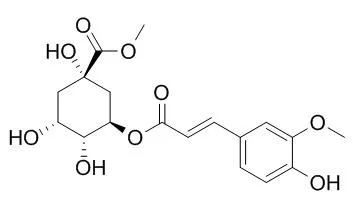| In vitro: |
| Yao Xue Xue Bao. 2015 Feb;50(2):207-10. | | Chemical constituents of the roots of Macleaya microcarpa and activation efficacy of benzophenanthridine alkaloids for the transcription of xbp1 gene.[Pubmed: 25975030] | Ongoing study on the chemical constituents of the roots of Macleaya microcarpa led to the isolation of eight compounds of derivatives of triterpenes and organic acids in addition to some previously identified benzophenanthridines.
METHODS AND RESULTS:
The eight compounds were identified by spectroscopic methods as well as comparison with literature values as 1-oxo-2, 22 (30)-hopandien-29-oic acid (1), 3-oxo-12-oleanen-30-oic acid (2), 3α-hydroxy-12-oleanen-30-oic acid (3), 3β-hydroxy-12-oleanen-30-oic acid (4), ferulic acid (5), ferulic acid 4-O-β-D-glucoside (6), 3-O-feruloylquinic acid (7), and Methyl 3-O-feruloylquinate (8). Of which, 1 is a new triterpenoid of hopanes and 2-8 are isolated from M microcarpa for the first time. In order to discover natural active compounds as potential agents of anti-ulcerative colitis (UC), an in vitro drug high-throughput screening model targeted x-box-binding protein 1 (xbp1) was employed to evaluate the activity of the major chemical constituents of M microcarpa.
CONCLUSIONS:
The result confirmed that two dihydrobenzophenanthridines, dihydrosanguinarine (9) and dihydrochelerythrine (10), showed a certain activity on activating the transcription of xbpl, a transcription factor (TF) associated with the occurrence, development, and potential treatment of UC, with their relative activating ratios being 1.76 and 1.77 times, respectively, as compared with control group. | | Biomed Res Int. 2014;2014:761849. | | Possible inhibitor from traditional Chinese medicine for the β form of calcium-dependent protein kinase type II in the treatment of major depressive disorder.[Pubmed: 25045698] | Recently, an important topic of major depressive disorder (MDD) had been published in 2013. MDD is one of the most prevalent and disabling mental disorders. Consequently, much research is being undertaken into the causes and treatment. It has been found that inhibition of the β form of calcium/calmodulin-dependent protein kinase type II (β-CaMKII) can ameliorate the disorder.
METHODS AND RESULTS:
Upon screening the traditional Chinese medicine (TCM) database by molecular docking, sengesterone, labiatic acid, and Methyl 3-O-feruloylquinate were selected for molecular dynamics. | | Biomed Res Int. 2014;2014:635152. | | The inhibition of folylpolyglutamate synthetase (folC) in the prevention of drug resistance in Mycobacterium tuberculosis by traditional Chinese medicine.[Pubmed: 25050369] | The selected TCM compounds Saussureamine C, Methyl 3-O-feruloylquinate, and Labiatic acid have been found to inhibit the activity of bacteria and viruses and to regulate immunity. We also suggest the possible pathway in protein for each ligand. Compared with the control, similar interactions and structural variations indicate that these compounds might have an effect on Folylpolyglutamate synthetase.
CONCLUSIONS:
Finally, we suggest Saussureamine C is the best candidate compound as the complex has a high score, maintains its structural composition, and has a larger variation value than the control, thus inhibiting the drug resistance ability of Mycobacterium tuberculosis. |
|






 Cell. 2018 Jan 11;172(1-2):249-261.e12. doi: 10.1016/j.cell.2017.12.019.IF=36.216(2019)
Cell. 2018 Jan 11;172(1-2):249-261.e12. doi: 10.1016/j.cell.2017.12.019.IF=36.216(2019) Cell Metab. 2020 Mar 3;31(3):534-548.e5. doi: 10.1016/j.cmet.2020.01.002.IF=22.415(2019)
Cell Metab. 2020 Mar 3;31(3):534-548.e5. doi: 10.1016/j.cmet.2020.01.002.IF=22.415(2019) Mol Cell. 2017 Nov 16;68(4):673-685.e6. doi: 10.1016/j.molcel.2017.10.022.IF=14.548(2019)
Mol Cell. 2017 Nov 16;68(4):673-685.e6. doi: 10.1016/j.molcel.2017.10.022.IF=14.548(2019)